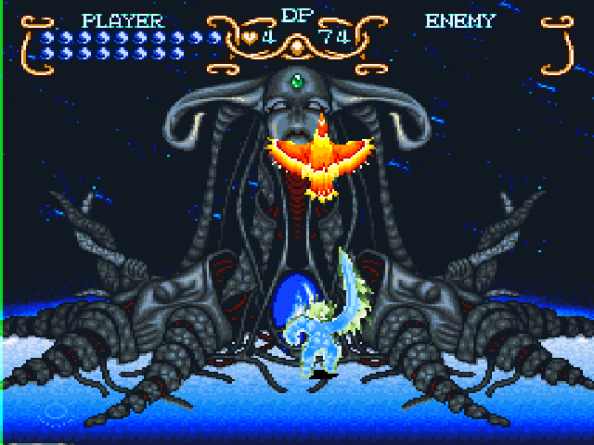
Much like many in the animal kingdom, the ancient warrior of light, when threatened, will wet himself as a defense mechanism.
And now a game that needs no introduction…but since I have to write one anyway, I had never heard of Illusion of Gaia when I pulled it out of the $10 clearance bin at Walmart. Yes, it could have been a broken, miserable, unplayable experience that left me empty and soulless, my lack of satisfaction made exponentially more crushing with every dollar I spent on it, but I had to face the facts, I would never get back the $2.50 I had spent renting Mario is Missing, nor would I get back the hour and a half of my life I sacrificed for a trivia game designed for people working their way up to the challenge of Dora the Explorer. And hey, it didn’t look half bad. The reason I had never heard of it probably came from the measly 650,000 copies it sold worldwide, less than half of which sold in the U.S.A. While that’s a big number and I wouldn’t mind selling 650,000 of anything (provided it’s not something bad like indentured servants or square cm of advertising space via tattoo), other games such as Link to the Past and Final Fantasy VI sold several million copies worldwide. And since Illusion of Gaia is in the same class of game as those two, get out your dark hoods, sacrificial knives and grab a spare chicken, because we’re going to celebrate Illusion of Gaia as a bona fide cult classic!
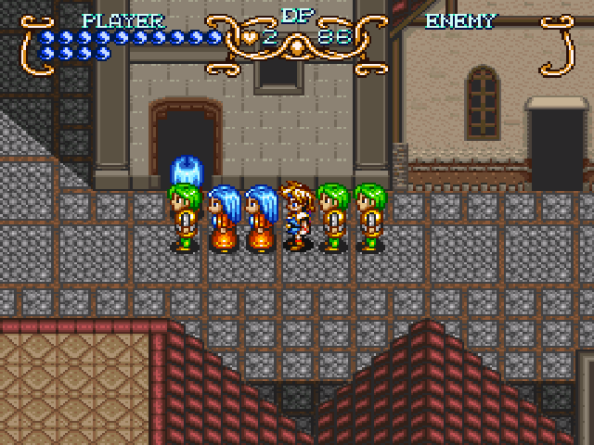
This is the most fun I had since playing the merchant in Dragon Quest IV.
Illusion of Gaia follows young Will, a boy who faces down swarms of demons armed with nothing more than a flute. And while that could set up an interesting Zelda-style mechanic where you use music to lull your opponents to sleep or pacify their hateful heart, Will doesn’t follow the path of the spooney bard so much as the style of Bam-bam Rubble. Gaia, the spirit of the earth, tasks will will traveling through the world’s ancient ruins to collect mystic statues that will enable him to destroy a comet careening toward their certain destruction. And the stingy broad doesn’t even offer so much as a “Heart” power ring. So Will travels the world with his friends, and we get to witness all his adventures, mishaps, the zany relationships between characters, the wonderful oddities along the way, and also the sheer devastation caused by the mystical comet in the past coupled with a dark subplot about a slave trade. You know. Good fun for a 15-year-old boy. The story is actually very good, a downright miracle when you realize it’s so poorly-written. Dialogue, especially near the beginning, reads like expository writing at a tourette’s convention, a collecting of disparate, unsolicited facts prematurely ejaculating themselves into the conversation. In one extended cut scene, Will announced that he’s starting to develop feelings for the princess. And then he drops unconscious with a case of scurvy. So the player has to let a lot of stuff slide, but the story moves along in a sensible manner like it should.
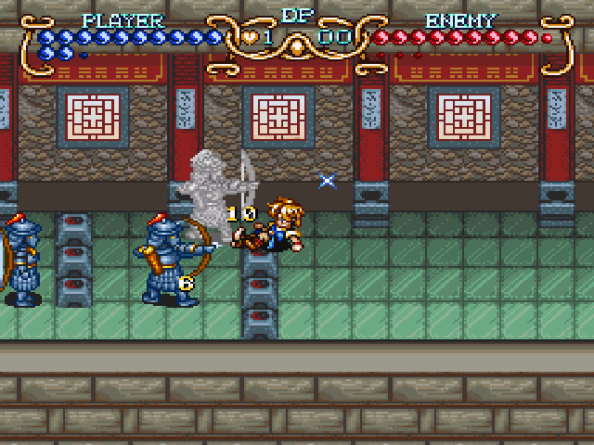
Will defaces a UNESCO World Heritage site, the Chinese Terra Cotta Soldiers.
The game technically plays out in our world, presumably in the far future after the comet has pulled its Chernoble impression six or seven times, halting world progress and handing evolution over to the whims of Salvador Dali. Will visits several real-world locations, such as the Nazca lines, the Incan ruins, Ankor Wat, the Great Wall of China. Still, the game plays fast and loose with geography, as though the developers failed their world map quiz in high school and decided to re-write the map so their answers would be correct. The Nazca lines are no longer on the same continent as the Incan ruins, Europe is now a single city somehow located west of China, but east of Cambodia, and Egypt is way off in the Northwest.
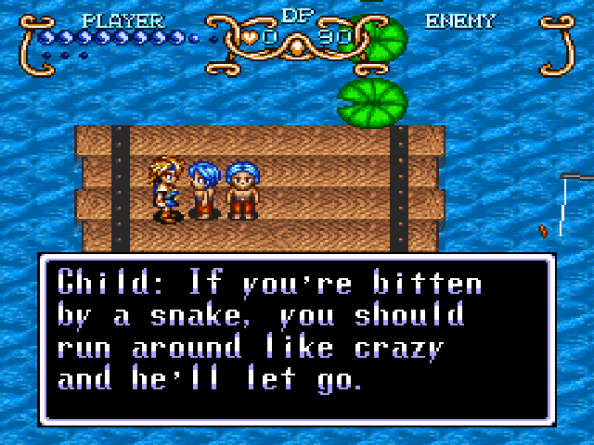
…good luck with that.
The combat system, aside from exhibiting a brutal violence toward band instruments, steals from action RPGs like Secret of Mana, while employing a unique system of leveling up. Rather than earning experience or equipping items, Will gets a stat bonus by clearing all the monsters in any given area (which he can only do once per area). With a limited number of stat increases, the difficulty in later stages depends on how thoroughly you can ethnically cleanse the earlier stages—which isn’t all that difficult, considering the generous head start that 16th century Spanish explorers gave you. Later on, the game ramps up the difficulty not only by making enemies harder, but by hiding one or two in each area. Not a bad idea, really, although it was a little frustrating running through the Ankor Wat hedge maze like Jack Torrence, playing a murderous game of Where’s Waldo as I hunted down the lone hedge monster I needed for my upgrade.
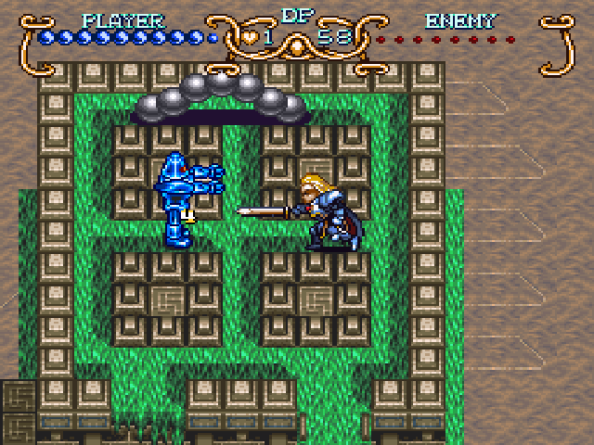
Freedan fights ancient Nazca robot while a string of anal beads looks on.
Will doesn’t have to run around jabbing his flute into things for the entire game. At various points he can transform into the Dark Knight Freedan, or Shadow, the bio-weapon made from the comet’s light, in what has to be the weirdest metaphor for puberty I’ve ever seen. Freedan and Shadow are both stronger than Will, but each character has a unique set of abilities that will be required to progress, so like any troubled teen, you’ll spend a lot of time altering your body in order to fight the evil establishment. While Will can perform special acrobatics, Freedan can reach across long distances, and Shadow can…make puddles on the floor like a dog that hasn’t been housebroken, all three characters have telekinetic powers. While mostly this is only good for a. collecting the mostly-useless items dropped by enemies and b. making the case that Will is “the chosen one,” it can also be used to block most projectile attacks. Because the best way to dodge a bullet is to stand right in front of it and pull it towards you with psychic force.
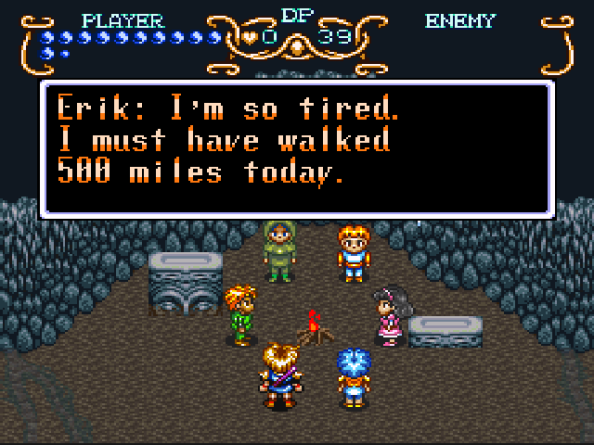
And I would walk 500 more…
I say the enemy drops are mostly useless as with very rare exception, they’re all gems that serve the basic purpose of Mario’s coins. That’s right. Illusion of Gaia has a life system. Instead of going back to the beginning of the stage when you die, if you’ve collected at least 100 gems, you’ll only go back to the beginning of the room you’re in. With severely diminished health. And any healing items you used before death are gone for good. And healing items are rare enough that they could be the subject of the next Indiana Jones movie. In most cases, it would be far easier to reset the game and start over from the last save point than to take the free life the game offers.
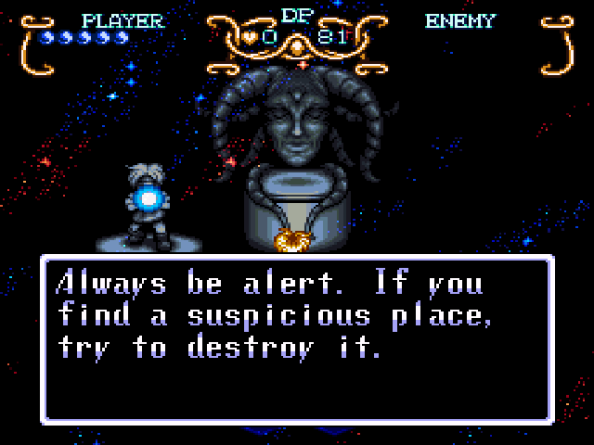
The George W. Bush homeland security policy. Gaia does a wicked harsh cavity search.
But really, these issues don’t amount to anything that might dissuade me from playing the game. Some of the more serious crimes involve key items being introduced with a text crawl so slow that it sets off a bomb on a bus somewhere and an end goal so confusing that even the main character questions why you’d want to replace the natural fantasy world with a modern urban sprawl. But if anyone told me these flaws actually amounted to something, I’d probably react the same was as if someone gave me a ticket for jaywalking.